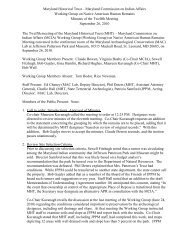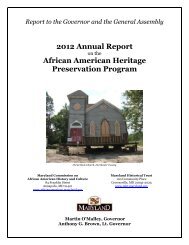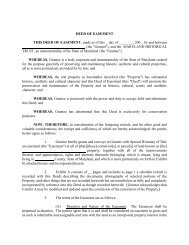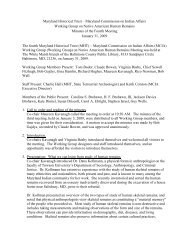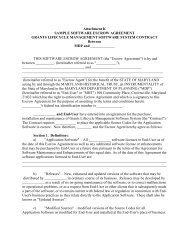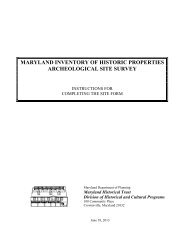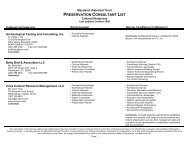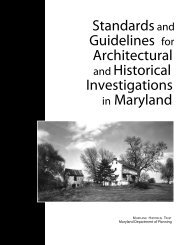The Maryland Preservation Plan - 2005 - Maryland Historical Trust
The Maryland Preservation Plan - 2005 - Maryland Historical Trust
The Maryland Preservation Plan - 2005 - Maryland Historical Trust
- No tags were found...
You also want an ePaper? Increase the reach of your titles
YUMPU automatically turns print PDFs into web optimized ePapers that Google loves.
<strong>The</strong> Status of Heritage Resources2. State Programs<strong>Maryland</strong> Inventory of Historic Properties<strong>The</strong> <strong>Maryland</strong> Inventory of Historic Properties is a broad based repositoryof information on districts, sites, buildings, structures, and objects of knownor potential value to the prehistory, history, upland and underwater archeology,architecture, engineering, or culture of <strong>Maryland</strong>. <strong>The</strong> inventory was createdshortly after the <strong>Maryland</strong> <strong>Historical</strong> <strong>Trust</strong> was founded in 1961, and nowincludes data on approximately 11,000 archeological sites and 140,000 historicaland architectural resources. Inclusion in the Inventory of Historic Propertiesinvolves no regulatory restrictions or controls. Materials included in the inventoryare maintained by the MHT Library and Archives.D. ProtectionAs <strong>Maryland</strong>'s population increases, so does the demand for newresidential, commercial, and industrial development. Although <strong>Maryland</strong>’s<strong>Plan</strong>ning Act of 1992 directs growth towards communities already containingadequate infrastructure, the continued urbanization of <strong>Maryland</strong> has increasedthe threat to the State's historic resources. New development in those historiccommunities designated as <strong>Maryland</strong>’s growth areas can adversely effecthistorical and cultural resources, as can sprawling development beyond urbancenters. Mechanisms which are successful at curbing or minimizing actions thatendanger the State’s heritage resources include the use of Historic <strong>Preservation</strong>Easements, Project Review and Compliance, and local preservation plans.1. Protective and Conservation EasementsEasements are used throughout <strong>Maryland</strong> to preserve historic, archeological,natural, and scenic properties. <strong>The</strong> State’s major holders of easementsare the <strong>Maryland</strong> <strong>Historical</strong> <strong>Trust</strong>, the <strong>Maryland</strong> Environmental <strong>Trust</strong>, the<strong>Maryland</strong> Agricultural Land <strong>Preservation</strong> Foundation, and local land trusts. Aneasement does not prevent alterations to a resource; rather the easement helpsmanage future changes that may occur.Historic <strong>Preservation</strong> EasementsMHT Easements are acquired through donations and as a condition of<strong>Trust</strong> grants, loans, and State bond funds. Gift easements are accepted onproperties listed on, or eligible for, the National Register of Historic Places orlocated within a locally-designated or National Register-listed historic district.Gift easement donations provide property owners with financial incentives andform an important part of estate planning. <strong>The</strong> <strong>Trust</strong> currently holds 566perpetual easements on 590 significant architectural and archeological propertiesencompassing nearly 10,900 acres. Easement properties include resourcessuch as a seventeenth century meeting house, eighteenth-, nineteenth-, andtwentieth century dwellings, schools, mills, farms and archeological sites.Certain local preservation organizations also accept preservation easements.Archeologists from MHT joined withmembers of the Archeological Society of<strong>Maryland</strong>, Inc. and the <strong>Maryland</strong>-NationalCapital Park and <strong>Plan</strong>ning Commission atthe Mt. Calvert Site, Prince George'sCounty, to search for the lost settlementof "Charles Town," the first county seat ofPrince George's County, during the 1997Annual Archeological Field Session.Archeological artifacts excavated at theFriendsville site, Garrett County, weremade c. AD 1400-1550 by peopleassociated with what archeologists callthe "Monongahela" culture. Pictured are:partial bird's beak (top); a decorated claysmoking pipe, drilled canine tooth, andtwo complete and one broken triangularstone projectile points or "arrowheads"(bottom, l. to r.).Underwater archeologists from MHT'sOffice of Archeology and volunteersexplore the remains of the 18th centuryStephen Steward shipyard in AnneArundel County. <strong>The</strong> shipyard wasburned by the British during the RevolutionaryWar because of its important rolein supplying ships to the Americans.17



